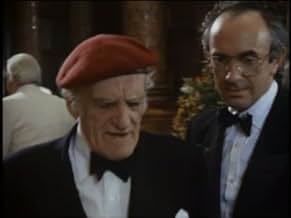The true story of the biggest fraud in publishing history - the Hitler diaries.The true story of the biggest fraud in publishing history - the Hitler diaries.The true story of the biggest fraud in publishing history - the Hitler diaries.
- Awards
- 1 win
Browse episodes
Storyline
Did you know
- TriviaTom Baker (Manfred Fischer) and Peter Capaldi (Thomas Walde) have both played the Doctor in "Doctor Who": Baker played the Fourth Doctor in Doctor Who (1963) from 1974 to 1981 while Capaldi played the Twelfth Doctor in Doctor Who (2005) from 2013 to 2017.
- ConnectionsReferences Newsnight (1980)
Featured review
Konrad "Connie" Fischer (Alexei Sayle), a.k.a. Konrad Kujau, was a con man who knew his mark. A "con man" or "confidence man" is a sophisticated cheat who uses fraud to deceive a mark out of his or her money. In this case, the mark was the international press. Gerd Heidemann, a journalist for the German magazine Stern, was facing a stalled career. He became the perfect target for a series of hoaxes known as the Hitler Diaries. This film portrays one of the greatest literary cons of the 20th century.
Heidemann needed something to jump-start his writing career to get back on track. In the series, he is portrayed as something of an amateur war scholar who enjoys collecting artifacts once owned by tyrants of infamous regimes. First, he buys Hermann Göring's yacht which looks like it might have come out of the Battle of the Bulge. Göring, the most eccentric and grandiose of Hitler's inner circle, was head of the Luftwaffe, the German Air Force during World War II. The journalist invests thousands of German marks to restore the vessel in hopes to invite former Nazis to board and tell stories about their experiences as budding Hitler youths. The boat does draw the former Nazis like a magnet, but the magazine Stern is unimpressed with Heidemann's results. They want something with more meat.
Heidemann then has a chance meeting with a Nazi memorabilia collector and sees an example of a supposed diary written by Hitler. After much persistence, the collector finally reveals his source, Konrad Fischer, a militaria dealer in Stuttgart. However, the collector balks at introducing them, but now the journalist has a name. Another of Heidemann's colleagues meets Fischer at a drinking party full of former Nazi sympathizers. They take old American songs and "arianize" them.
Heidemann finally meets Fischer and wants to see if there are more diaries with the possibility of acquiring them. Fischer shows him a few volumes. Convinced of their authenticity, Heidemann gets financing from his publication. Asked how he acquired them, Fischer tells him a story, which is a vital part of any con game. Fischer claims they are from his brother who is a high-ranking officer in East Germany which was then under the Soviet Iron Curtain. The diaries and other material were supposedly retrieved from a plane which crashed in 1945 containing Nazi documents, art, and artifacts, including paintings and supposedly an opera by Hitler. The diaries are smuggled out of East Germany to West Germany aboard a truck hauling pianos between the countries. Fischer finally agrees to give Heidemann several diaries for the princely sum of 200,000 marks per volume, about US $250,000 in 2010. Essentially, Fischer sells them to Heidemann who in turn sells them to Stern for a profit. Once the first sale is made, the hoax has been engaged, and Heidemann returns frequently with more money for more diaries. By the end, there will be 58 diaries in all.
Heidemann makes money as the go-between and becomes a major player in the publication. Stern is convinced they will make a fortune in their own publication plus they will sell the rights to international press markets, such as those owned by Rupert Murdoch and Newsweek in the US. Everyone is happy. Except there is only one problem. The diaries are complete fakes, forged by Fischer in a back room with a calligraphic pen and a host of literature regarding the Nazis which could be found at any library. There is no "brother" in East Germany and no evidence that the crashed plane contained the material supposedly found there by peasants.
However, handwriting experts and other scholars are convinced of their authenticity. Will this be the greatest literary find of the century, or the worst literary con played on the press who wanted to feed the public's continued appetite for all things regarding Hitler and the Nazis in Germany? A compelling chronicle of events of the Hitler Diaries, with strange Monty Python-esque interludes with Pryce looking like a character out of a Wagnerian opera. Not to be missed for those who like hoaxes and Hitler.
Heidemann needed something to jump-start his writing career to get back on track. In the series, he is portrayed as something of an amateur war scholar who enjoys collecting artifacts once owned by tyrants of infamous regimes. First, he buys Hermann Göring's yacht which looks like it might have come out of the Battle of the Bulge. Göring, the most eccentric and grandiose of Hitler's inner circle, was head of the Luftwaffe, the German Air Force during World War II. The journalist invests thousands of German marks to restore the vessel in hopes to invite former Nazis to board and tell stories about their experiences as budding Hitler youths. The boat does draw the former Nazis like a magnet, but the magazine Stern is unimpressed with Heidemann's results. They want something with more meat.
Heidemann then has a chance meeting with a Nazi memorabilia collector and sees an example of a supposed diary written by Hitler. After much persistence, the collector finally reveals his source, Konrad Fischer, a militaria dealer in Stuttgart. However, the collector balks at introducing them, but now the journalist has a name. Another of Heidemann's colleagues meets Fischer at a drinking party full of former Nazi sympathizers. They take old American songs and "arianize" them.
Heidemann finally meets Fischer and wants to see if there are more diaries with the possibility of acquiring them. Fischer shows him a few volumes. Convinced of their authenticity, Heidemann gets financing from his publication. Asked how he acquired them, Fischer tells him a story, which is a vital part of any con game. Fischer claims they are from his brother who is a high-ranking officer in East Germany which was then under the Soviet Iron Curtain. The diaries and other material were supposedly retrieved from a plane which crashed in 1945 containing Nazi documents, art, and artifacts, including paintings and supposedly an opera by Hitler. The diaries are smuggled out of East Germany to West Germany aboard a truck hauling pianos between the countries. Fischer finally agrees to give Heidemann several diaries for the princely sum of 200,000 marks per volume, about US $250,000 in 2010. Essentially, Fischer sells them to Heidemann who in turn sells them to Stern for a profit. Once the first sale is made, the hoax has been engaged, and Heidemann returns frequently with more money for more diaries. By the end, there will be 58 diaries in all.
Heidemann makes money as the go-between and becomes a major player in the publication. Stern is convinced they will make a fortune in their own publication plus they will sell the rights to international press markets, such as those owned by Rupert Murdoch and Newsweek in the US. Everyone is happy. Except there is only one problem. The diaries are complete fakes, forged by Fischer in a back room with a calligraphic pen and a host of literature regarding the Nazis which could be found at any library. There is no "brother" in East Germany and no evidence that the crashed plane contained the material supposedly found there by peasants.
However, handwriting experts and other scholars are convinced of their authenticity. Will this be the greatest literary find of the century, or the worst literary con played on the press who wanted to feed the public's continued appetite for all things regarding Hitler and the Nazis in Germany? A compelling chronicle of events of the Hitler Diaries, with strange Monty Python-esque interludes with Pryce looking like a character out of a Wagnerian opera. Not to be missed for those who like hoaxes and Hitler.
- classicalsteve
- Aug 4, 2011
- Permalink
Details
- Release date
- Country of origin
- Language
- Also known as
- Hitler zu verkaufen
- Production company
- See more company credits at IMDbPro
Contribute to this page
Suggest an edit or add missing content



















